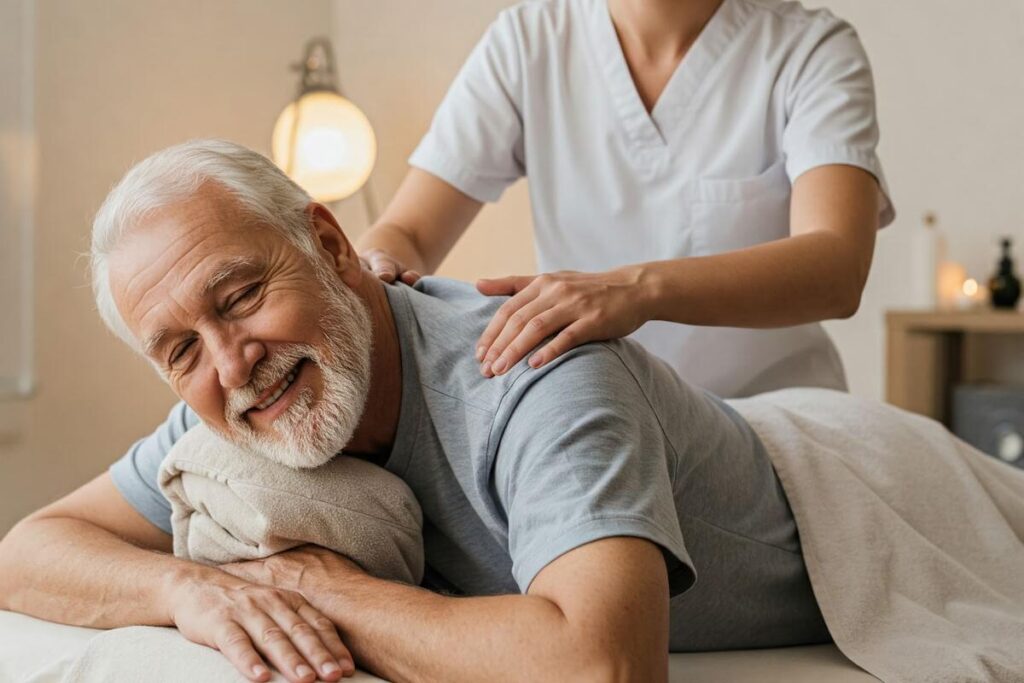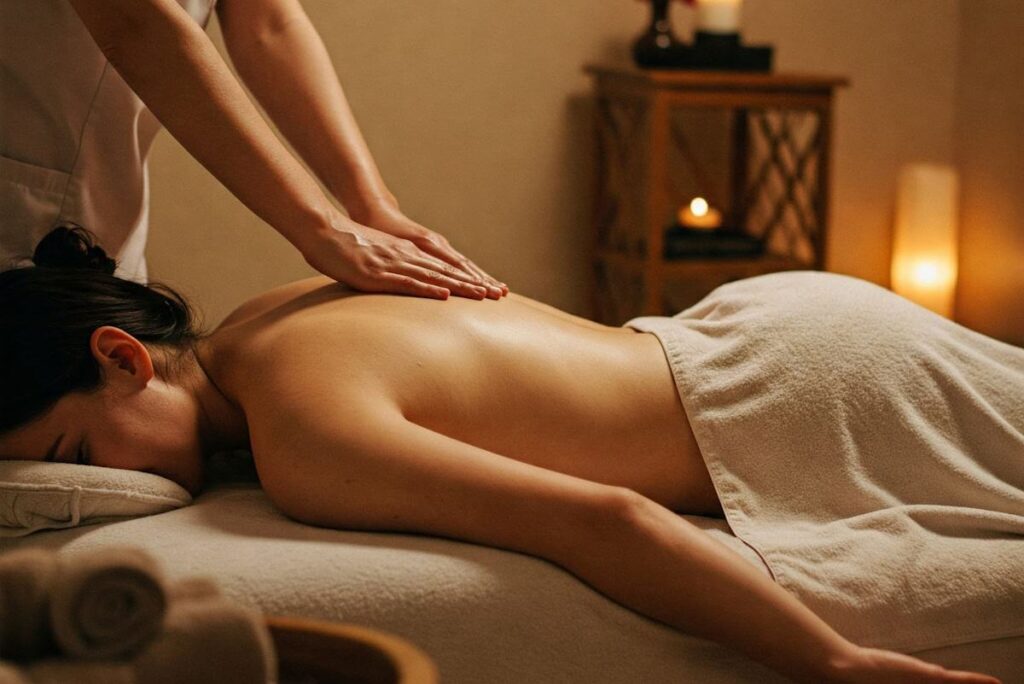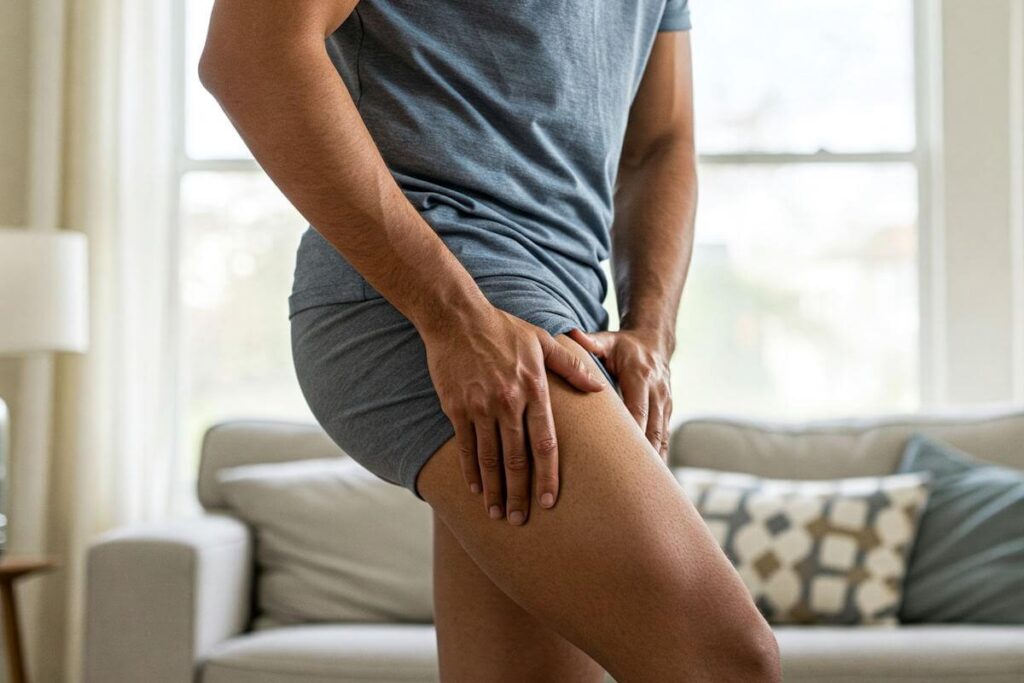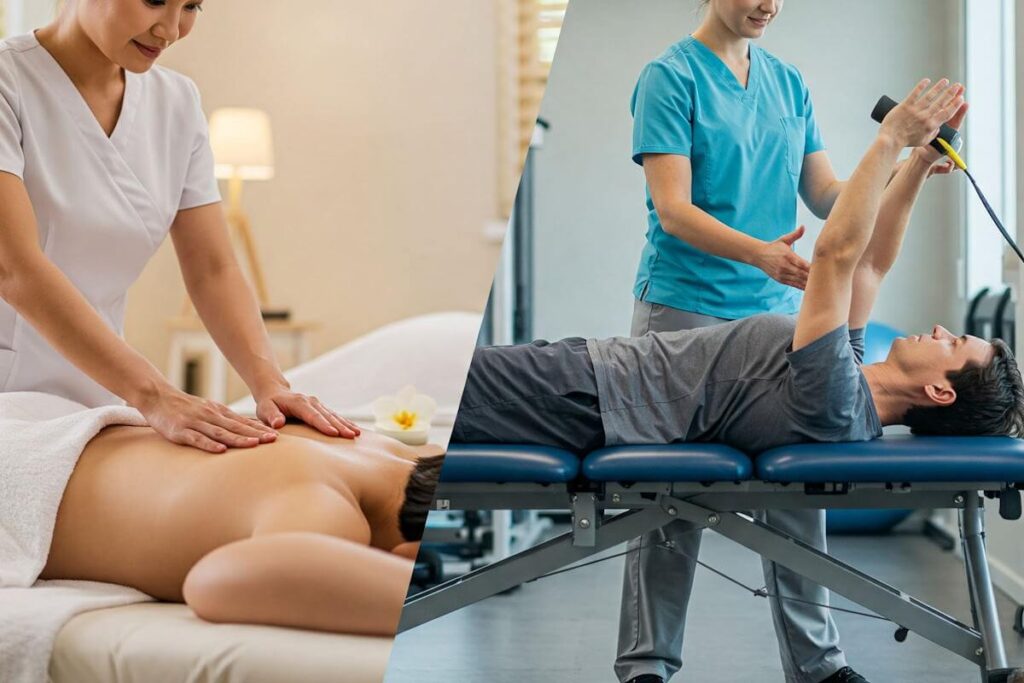Introduction to Massage Therapy for Seniors
Massage therapy has gained considerable recognition as a vital tool for enhancing well-being and improving quality of life, particularly among seniors. As individuals age, they often experience various physical and emotional challenges, including chronic pain, reduced mobility, anxiety, and depression. Massage offers a healing touch that can alleviate these issues, making it an increasingly popular choice among older adults seeking relief and comfort.
The therapeutic benefits of massage therapy extend beyond relaxation; it aids in improving circulation, reducing muscle tension, and enhancing overall mobility. For seniors, who may be prone to conditions such as arthritis or osteoporosis, specific types of massage, such as Swedish, deep tissue, or gentle myofascial release, can be particularly beneficial. Each type varies in technique and intensity, allowing for tailored approaches that cater to the unique needs of older adults.
Another significant aspect of massage therapy is the importance of touch as a healing mechanism. For many seniors, especially those who may experience social isolation, regular massage therapy sessions can promote emotional well-being by fostering a sense of connection and comfort. The act of touch can stimulate the release of oxytocin, a hormone that reduces anxiety and stress levels and enhances feelings of happiness. Consequently, massage can simultaneously address both physical and emotional ailments, providing a holistic approach to health in later life.
As we explore the growing popularity and multifaceted benefits of massage therapy for seniors, it is essential to recognize the transformative power of touch in promoting healing, enhancing mobility, and contributing to a more fulfilling life experience for older adults.
Physical Benefits of Massage for Seniors
As individuals age, they often experience a variety of physical challenges, including increased muscle tension, decreased flexibility, and poor circulation. Regular massage therapy can serve as a significant remedy, providing numerous physical health benefits for seniors. One of the prominent advantages is effective pain relief. Many older adults suffer from chronic pain conditions, such as arthritis or lower back pain. Massage therapy can help alleviate this pain by promoting relaxation and decreasing muscle tension. The gentle pressure applied during a massage can trigger the release of endorphins, the body’s natural painkillers, enhancing comfort and well-being.
Improved circulation is another substantial benefit associated with massage for seniors. With age, the cardiovascular system can weaken, leading to issues such as poor blood flow. Massage techniques stimulate blood flow, increasing oxygen and nutrient delivery to tissues while supporting the removal of metabolic waste. Enhanced circulation aids in the recovery of injuries and reduces the risk of complications related to poor vascular health, resulting in a more vibrant and energetic lifestyle.
Flexibility can also be significantly enhanced through regular massage therapy. The gentle stretching and manipulation of muscles promote increased range of motion in joints, helping seniors maintain their mobility. This improvement in flexibility can lead to a reduced risk of falls, a common concern among the elderly. Furthermore, regular massage helps in reducing tension within muscles, promoting relaxation and improving overall physical comfort. By addressing muscular tightness, seniors may experience better posture and alignment, which can further contribute to enhanced mobility.
Incorporating massage therapy into the regular health regimen of seniors not only leads to physical benefits but also contributes positively to their overall quality of life. By addressing pain, circulation issues, flexibility, and tension, seniors can enjoy daily activities with greater ease and confidence.
Mental and Emotional Advantages of Massage
Massage therapy has long been recognized for its physical benefits, but its impact on mental and emotional well-being, particularly among seniors, is equally significant. As individuals age, they may experience increased levels of anxiety and depression due to various factors such as physical limitations, loss of loved ones, or chronic health conditions. Incorporating regular massage sessions into a senior’s routine can provide a welcomed relief from these pressing issues.
One of the primary emotional advantages of massage is its ability to promote relaxation. This form of therapy stimulates the body’s relaxation response, effectively lowering cortisol levels—the hormone primarily associated with stress. As tension melts away, seniors often report feeling calmer and more centered, which can have a profound effect on their overall mental wellness. This state of relaxation also paves the way for improved sleep patterns, addressing insomnia and enhancing daytime alertness and mood.
Moreover, the physical touch associated with massage can stimulate the brain’s release of endorphins and other neurochemicals, facilitating a natural boost in mood. Endorphins act as natural pain relievers and contribute to a sense of happiness, which is particularly beneficial for seniors who may struggle with feelings of loneliness or isolation. These neurochemical shifts not only foster an immediate feeling of well-being but can also lead to long-term emotional benefits.
In addition to reducing symptoms of anxiety and depression, massage therapy encourages seniors to engage with their bodies in a positive way. This can enhance their body awareness and overall self-esteem, allowing them to embrace aging with more positivity. As a result, the integration of massage into a senior’s lifestyle can serve as a vital component of maintaining mental and emotional health, affirming its importance in holistic well-being.
Social Connection through Massage
Massage therapy is not only beneficial for physical health but also plays a significant role in enhancing social connections among seniors. As individuals age, they often face increased isolation, leading to feelings of loneliness and depression. Engaging in regular massage sessions can provide much-needed human interaction, fostering relationships between practitioners and clients, as well as among fellow patients receiving therapy. This regular exposure to others creates opportunities for meaningful connections that may otherwise be rare.
The therapeutic environment of a massage therapy session encourages open communication and emotional expression, which can lead to the sharing of personal stories, experiences, and memories. This not only alleviates the feeling of isolation but also creates a supportive network where seniors can feel valued and understood. Additionally, many massage therapy centers offer group sessions or classes, enabling participants to socialize and develop friendships with peers who share similar challenges and goals.
Furthermore, the physical touch experienced during a massage signifies warmth and compassion, fostering a sense of belonging and emotional security. For seniors, this human contact is crucial since they may experience a decline in physical interactions in their daily lives. By providing a space for emotional support, massage therapy can significantly contribute to a senior’s mental health and overall well-being.
Participating in massage therapy not only addresses physical ailments but also acts as a catalyst for improved social interaction. The bonds formed through shared experiences during these sessions can lead to lasting friendships, enhancing the quality of life for seniors. As a result, massage therapy serves a dual purpose – promoting physical wellness and fostering vital social connections that combat loneliness and enrich emotional health.
Types of Massage Techniques Beneficial for Seniors
Massage therapy encompasses various techniques, each with distinct benefits that can greatly enhance the well-being of seniors. Among these, Swedish massage is one of the most popular, known for its gentle strokes accompanied by soothing oils. This technique primarily promotes relaxation and improves circulation, making it particularly suitable for older adults who may contend with stiffness or minor aches. The light pressure used in Swedish massage encourages the release of tension and aids in overall mental wellness.
Another effective method is deep tissue massage, which utilizes firmer pressure to target deeper layers of muscle and connective tissue. This technique is particularly beneficial for seniors experiencing chronic pains or muscular discomfort due to conditions such as arthritis. While the pressure is more intense, the long-term benefits include enhanced mobility, decreased pain sensitivity, and improved muscle function. However, it’s important for older adults to consult with a healthcare professional to ensure this technique is suitable for their health circumstances.
Gentle touch massage is another approach that focuses on offering comfort rather than treating specific ailments. This technique employs light pressure and rhythmic movements, making it ideal for those with heightened sensitivity or certain health limitations. Many seniors find this method not only calming but also beneficial for reducing anxiety, which is crucial for their mental health.
In addition to these classic techniques, complementary therapies like aromatherapy and chair massage can also be beneficial. Aromatherapy incorporates essential oils to enhance relaxation and emotional well-being. Meanwhile, chair massage offers convenient relief that accommodates seniors who may have difficulty lying on a massage table. Each of these techniques promotes well-being in a manner tailored to the unique needs and preferences of aging adults.
Safety Considerations and Contraindications
As more seniors explore the therapeutic benefits of massage, it is essential to understand the safety considerations and potential contraindications associated with massage therapy. While many older adults can benefit significantly from massage, certain health conditions may pose risks that must be carefully evaluated. Seniors should approach massage therapy with caution and always consult healthcare professionals before initiating any new treatment regimen.
Among the primary concerns are pre-existing medical conditions, such as osteoporosis, severe arthritis, or cardiovascular issues. For seniors with osteoporosis, the risk of fractures can increase with certain types of deep tissue massage, necessitating a gentler technique. Additionally, seniors suffering from heart conditions may need to avoid massages that increase their heart rate or involve pressure on the chest area. It is crucial for practitioners to assess each individual’s health history and tailor the approach accordingly.
Moreover, certain medications might influence sensitivity to massage. For instance, those on anticoagulants, such as blood thinners, should be cautious, as they may experience increased bruising or bleeding. It is advisable for seniors to communicate openly with both their physician and massage therapist about any medications they are taking, ensuring a safe and effective experience.
In addition to medical considerations, seniors should also reflect on their comfort levels, mobility, and any cognitive challenges when deciding to engage in massage. A serene environment and a skilled therapist who understands the nuances of working with older populations can significantly enhance the experience. Ultimately, proper consultation and individualized attention can render massage therapy a safe and beneficial practice for seniors, promoting well-being and relaxation without compromising health.
Finding the Right Massage Therapist for Seniors
As seniors seek therapeutic benefits through massage, finding a qualified therapist who understands the unique needs of older adults becomes paramount. The ideal massage therapist should possess specialized training and experience in geriatric care. Therefore, it is essential to begin by investigating local massage practices to identify those with a focus on senior clients. One way to verify a therapist’s qualifications is by checking their certifications and any specialized training in geriatric massage techniques. Look for therapists who are licensed and have completed relevant coursework on the physical concerns of older adults.
When interviewing potential therapists, asking pertinent questions is crucial. Inquire about their experience working with seniors, the types of massage techniques they utilize, and any specific health conditions they are familiar with. It is also beneficial to discuss the therapy approach they intend to use, ensuring it aligns with the senior’s medical history and comfort levels. Another significant factor to consider is the therapist’s understanding of the potential benefits of massage for seniors, such as improved circulation, reduced muscle tension, and enhanced emotional well-being.
Furthermore, personal comfort and trust play critical roles in the therapist-client relationship. Seniors should feel at ease communicating their preferences, concerns, and any discomfort during the session. Scheduling an introductory meeting or trial session can facilitate this connection, allowing seniors to gauge their comfort and interaction with the therapist. Caregivers should also be involved in this process, as they can provide additional insights into what might best suit the needs of seniors they assist. Ultimately, taking the time to find the right massage therapist can significantly contribute to the overall health and quality of life for older adults.
Incorporating Massage into a Senior Wellness Routine
Integrating massage therapy into a senior’s wellness routine can significantly enhance their overall health and quality of life. Regular massage can help alleviate various age-related issues, including joint stiffness, muscle tension, and stress. To maximize the benefits of massage, it is essential to establish a consistent schedule. Ideally, seniors should aim for a massage session once a week or every other week, depending on their personal preferences and health needs. Such frequency can foster a sense of relaxation and allow the body to reap the cumulative benefits of therapeutic touch.
Complementary activities can further enhance the effects of massage therapy. For instance, gentle stretching exercises or yoga can improve flexibility and help maintain mobility, which are crucial for seniors. Engaging in deep-breathing exercises can also complement the tranquil nature of massage, promoting relaxation and reducing anxiety. Additionally, after a massage, seniors might benefit from a warm bath or a quiet period of meditation to prolong the feeling of relaxation and well-being achieved through the treatment.
Creating a harmonious environment for massage is vital for a truly relaxing experience. Seniors should consider setting aside a designated space in their home where they feel safe and comfortable. This area can be enhanced with soft lighting, calming scents from essential oils, and soothing music. Such an atmosphere not only promotes relaxation but also encourages the senior to view massage as a vital part of their wellness journey.
In conclusion, by integrating regular massage therapy into a senior’s wellness routine, alongside complementary practices and a serene environment, they can significantly enhance their physical and emotional well-being. This holistic approach ensures that the benefits of massage extend beyond the treatment itself, fostering a healthier and more balanced lifestyle.
Conclusion: Embracing the Power of Touch
As we reflect on the profound effects of massage therapy on senior health and well-being, it becomes clear that the power of touch is an invaluable asset in promoting a better quality of life during the golden years. Massage serves not only as a source of physical relief but also as a therapeutic method that fosters emotional connection and support. For seniors, many of whom face challenges such as chronic pain, social isolation, or mobility issues, integrating regular massage into their routines can lead to significant improvements in both mental and physical health.
Moreover, the benefits of massage extend beyond immediate relaxation. Research has shown that massage can enhance circulation, reduce stiffness, and alleviate common age-related ailments. In addition, the engaging nature of tactile stimulation can help combat feelings of loneliness, contributing positively to emotional well-being. This indicates that proper care that includes massage therapy can be an effective way for seniors to embrace their later years with vitality and joy.
Ultimately, embracing the therapeutic power of touch can be transformative for older adults. It is not merely the act of massage that is beneficial but the intention—conveying care and compassion through human interaction. Senior individuals can significantly enhance their physical comfort and emotional happiness by incorporating massage into their health care routines. Therefore, it is highly encouraged for caregivers and family members to prioritize massage therapy as part of their holistic approach to senior care. In doing so, they facilitate a nurturing environment that fosters healing, promotes resilience, and supports the overall well-being of their loved ones, making every moment in their golden years as comfortable and joyful as possible.




